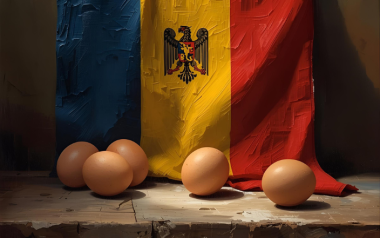The global environment, in most of the world markets, is being very conditioned by two factors repeatedly commented and known by all.
10 Mar 2020
How is the market of raw materials for animal feed in March?
Content available at: Español (Spanish) The global environment, in most of the world markets, is being very conditioned by two […]
Available in other languages:
Content available at:
Español (Spanish)
 On the one hand, the effects of Coronavirus originating in China , which, according to the government of that country, begins to decrease the level of contagion, which is always good news. However, cases continue to appear and spread in other countries such as Italy, which increases concern and affects international exchanges causing significant declines.
On the one hand, the effects of Coronavirus originating in China , which, according to the government of that country, begins to decrease the level of contagion, which is always good news. However, cases continue to appear and spread in other countries such as Italy, which increases concern and affects international exchanges causing significant declines.
![]() Obviously, this situation of blocking people causes in turn the commercial stop in a country, accumulating containers in ports of reception and dispatch, as well as a minimum delay of the days of navigation that the goods need to move . This will be regularized after the lifting of restrictions by the authorities when the situation progresses.
Obviously, this situation of blocking people causes in turn the commercial stop in a country, accumulating containers in ports of reception and dispatch, as well as a minimum delay of the days of navigation that the goods need to move . This will be regularized after the lifting of restrictions by the authorities when the situation progresses.
On the other, the commercial war that the United States has with China, which is in the first phase of an agreement that, if fulfilled, will be done very slowly. China does not have a scenario to be able to buy American raw materials until the recovery of pig production begins.
![]() In addition, they must compete with other points on the planet that will have, predictably, and as we will see later, a large volume of production . More specifically the South American countries .
In addition, they must compete with other points on the planet that will have, predictably, and as we will see later, a large volume of production . More specifically the South American countries .



As I write this text, the price of Wheat in Chicago goes up 25 cents . We would say that it is the tip of a very bad Australian harvest after drought, fires , etc. The USDA reduces it to 15 million tons, the lowest in 12 years.

For fundamental arguments, we think that wheat is overvalued . Since the harvest of cereal of the present campaign, where it made minimum prices in the month of September 2019 (see graph), the price increases have been continuous.
In addition, looking at the record long positions of investment funds, we might think that if they decide to liquidate as of March, also thinking of crop arrivals are two downward factors.
We started talking about estimates for new crops. At the moment the forecast for Central Europe is slightly lower than last year. The absence of autumnal rains was a handicap for planting the entire initially estimated area and should have planted more barley in that part.
![]() Therefore, the estimated volume would decrease around -6 million tons.
Therefore, the estimated volume would decrease around -6 million tons.
As for Eastern Europe, it seems that Russia, Ukraine and Romania are in very good condition.

Additionally, India expects a much better harvest than usual , which can lead to export 5/6 million tonnes, which would partly compensate for the loss of the Australian crop, which was damaged this campaign.

In contrast, the situation for corn is much more stable. It is true that at the moment it is far from the low prices of the beginning of the campaign and the minimum seen two years ago, although we are aware of two factors:
![]() The competitive price is allowing a very high consumption interest in its markets. Industrial, Ethanol and Feed.
The competitive price is allowing a very high consumption interest in its markets. Industrial, Ethanol and Feed.
![]() Security stocks are reduced in the last two campaigns.
Security stocks are reduced in the last two campaigns.
Even so, exports, for example, in the US, are not reaching the minimum expected by the USDA, motivated mainly by China and its lack of interest in that corn.
 Looking forward to the next campaign in South America, the estimate is still very positive , with Brazil at 100 million MT and Argentina waiting for 50 million. The weather seems excessively rainy for the time and may be delaying the planting of the second Brazilian harvest, but it is not news or alarming situation.
Looking forward to the next campaign in South America, the estimate is still very positive , with Brazil at 100 million MT and Argentina waiting for 50 million. The weather seems excessively rainy for the time and may be delaying the planting of the second Brazilian harvest, but it is not news or alarming situation.
This high availability leads us to think that the price levels that we could reach in the minimums during the month of August or September in the international market could resemble those of the last campaign , provided that the crops flow in an environment of normality.

Although we will have to assess well the domestic consumption that Brazil will make of corn for ethanol production, as we saw not only last year but next year, it will increase its production considerably , consequently, we will assume that exports will decline.

The most significant thing for barley today is the stocks available even in the interior of the peninsula, which are allowing the lowest price cereal of all to be used in production plants in the interior and coming to compete in areas of consumption very close to ports
![]() At the moment, it is true that the situation of the field in Spain is very good after correct plantings and a favorable climate, although not too cold in February, which is advancing in some areas between 15 and 20 days the state of the harvest.
At the moment, it is true that the situation of the field in Spain is very good after correct plantings and a favorable climate, although not too cold in February, which is advancing in some areas between 15 and 20 days the state of the harvest.
This could jeopardize the breadth of possible contingencies that may arise during spring on the peninsula , since we historically know the damage that can be done by a dry spring, or an excess of punctual heat , and even inopportune frosts if the plant is in processes of pomegranate
Everything is about to clear, according to the data in each moment we will have to interpret in a continuous way what is happening.
In Europe, on the other hand, the data of cultivated area (to the detriment of the Wheat) are superior and the world estimates, for the moment, point to a year of greater availability of this cereal.


![]() Soy
Soy
Much more peace of mind in protein prices.
The South American crops continue with a favorable climate waiting for a couple of weeks of generous rains that will allow the correct development of the final stretch of the crops.
![]() The volume estimates for Brazil and Argentina remain between them at 176 million MT, which would end up talking about record harvest one more year.
The volume estimates for Brazil and Argentina remain between them at 176 million MT, which would end up talking about record harvest one more year.

Therefore, and together with the high global stocks, we believe that the offer will remain fluid . Logistic flows may change again if China, after its new agreement with the US, finally more importantly supplies its need for this campaign again with that country instead of with Brazil, as it has had to do during the last two campaigns.
Investment funds , as we see in the graphs, hold shorter positions than previous years in both beans and soybean meal. The situation obviously invites you to it.

The other sources of protein have no choice but to accompany the prices of soybean meal , looking for a decent level of interest demand, since consumption for animal feed of soybeans are being very high.
![]() Colza flour does not finish competing and we begin to see already inverted offers for new European harvest positions from August at levels of € 220 / tm in ports in the northern peninsular.
Colza flour does not finish competing and we begin to see already inverted offers for new European harvest positions from August at levels of € 220 / tm in ports in the northern peninsular.
![]() Few positions of coverage are being made by manufacturers. The European availability of Seed today seems to be quite positive.
Few positions of coverage are being made by manufacturers. The European availability of Seed today seems to be quite positive.
Corn Solubles , on the other hand, continue at a high price for their relative value , it is true that the volume that is coming from the USA to our destination continues to be important and the offer is fluid.
![]() Now, for the April / June period, these last days have become complicated, reaching a price of € 238 / tm for importation.
Now, for the April / June period, these last days have become complicated, reaching a price of € 238 / tm for importation.
![]() We think it will lower the demand in part on it and return to the previous levels, closer to € 230 / tm.
We think it will lower the demand in part on it and return to the previous levels, closer to € 230 / tm.

![]() Corn
Corn
The quantity of product in ports requires operations with a price discount in the line of € 180/181 / tm for available, being at € 185 / tm for closures until May / June. As of August, offers range from around € 178 / tm, although interest is lower. High global consumption can cause specific increases or tensions in prices during the months of May to July . The rest of the periods we would say are more stable.
![]() Wheat
Wheat
 Nothing changes in the international replenishment , it remains above € 215 / tm in Spanish ports and the coverage is still scarce. We do not expect invented arrivals and liquidity at some times will be very scarce until harvest link. Therefore, we think that prices in the interior will rise in the next month . The total peninsular demand is to be covered from March 20 until campaign linkage and prices in the originating provinces can rise between € 6/10 / tm over current values, also dragging the barley, although to a lesser extent.
Nothing changes in the international replenishment , it remains above € 215 / tm in Spanish ports and the coverage is still scarce. We do not expect invented arrivals and liquidity at some times will be very scarce until harvest link. Therefore, we think that prices in the interior will rise in the next month . The total peninsular demand is to be covered from March 20 until campaign linkage and prices in the originating provinces can rise between € 6/10 / tm over current values, also dragging the barley, although to a lesser extent.
Any news regarding the development of the plant due to adverse weather conditions would cause such a strong retention that it would even cause an additional rise.
![]()
![]() Barley
Barley
It will depend on the strength of the wheat, but its price curve will be similar . Possibility of going up during March for coverage from 20 March to 30 April and if the weather respects, it would open a path to decrease the price towards a new campaign in June.
![]() Soy
Soy
 Chicago prices are very lateral and interesting values, while a currency exchange is penalizing us a lot of net prices and some bases that we consider high for the expected availability in South America.
Chicago prices are very lateral and interesting values, while a currency exchange is penalizing us a lot of net prices and some bases that we consider high for the expected availability in South America.
If China does not go out to buy, we think of somewhat better net prices for May-August, based on more negative bases. Few arguments at the moment to think that you can or should raise the price significantly.
![]() Wheat Bran
Wheat Bran
 We were announcing last month the decline of some fibers . Seasonally, February and March are months of low global demand for this type of food, so March prices will be forced down. However, its nutritional value seems interesting . We should maximize its% incorporation in formulations.
We were announcing last month the decline of some fibers . Seasonally, February and March are months of low global demand for this type of food, so March prices will be forced down. However, its nutritional value seems interesting . We should maximize its% incorporation in formulations.
![]() Bales / Pellet of Alfalfa
Bales / Pellet of Alfalfa
 It seems that for the second consecutive year the Alfalfa campaign could be smaller on the peninsula . At the moment it does not seem to be having an impact on prices, but I would say that we should not expect declines.
It seems that for the second consecutive year the Alfalfa campaign could be smaller on the peninsula . At the moment it does not seem to be having an impact on prices, but I would say that we should not expect declines.
![]() Soybean husk
Soybean husk
 Until the arrival of Argentine harvest and greater availability of Shell in this origin, it seems that we can have a complicated campaign link with very high prices . Today € 185 / tm in Coruña or € 175 / tm departure from national Extractors.
Until the arrival of Argentine harvest and greater availability of Shell in this origin, it seems that we can have a complicated campaign link with very high prices . Today € 185 / tm in Coruña or € 175 / tm departure from national Extractors.
Sources of Information: AEFA, US Grain Council, USDA, FC Stone, Reuters, International Grains Council, CRM Agri, CME Group, Global Agritrends, Kevin Van Trump and Eurotrade Agrícola.
PM-ES-20-0019
Elanco and the slash are registered trademarks of Elanco or its subsidiaries
© 2020 Elanco Animal Health, Inc. or its affiliates.




































